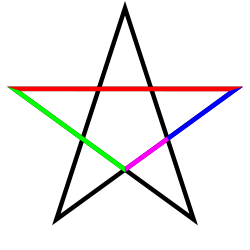Metallic mean
The metallic mean (also metallic ratio, metallic constant, or noble mean[1]) of a natural number n is a positive real number, denoted here that satisfies the following equivalent characterizations:
- the unique positive real number such that
- the positive root of the quadratic equation
- the number
- the number whose expression as a continued fraction is
Metallic means are (successive) derivations of the golden () and silver ratios (), and share some of their interesting properties. The term "bronze ratio" () (Cf. Golden Age and Olympic Medals) and even metals such as copper () and nickel () are occasionally found in the literature.[2][3][a]
In terms of algebraic number theory, the metallic means are exactly the real quadratic integers that are greater than and have as their norm.
The defining equation of the nth metallic mean is the characteristic equation of a linear recurrence relation of the form It follows that, given such a recurrence the solution can be expressed as
where is the nth metallic mean, and a and b are constants depending only on and Since the inverse of a metallic mean is less than 1, this formula implies that the quotient of two consecutive elements of such a sequence tends to the metallic mean, when k tends to the infinity.
For example, if is the golden ratio. If and the sequence is the Fibonacci sequence, and the above formula is Binet's formula. If one has the Lucas numbers. If the metallic mean is called the silver ratio, and the elements of the sequence starting with and are called the Pell numbers.
Geometry

The defining equation of the nth metallic mean induces the following geometrical interpretation.
Consider a rectangle such that the ratio of its length L to its width W is the nth metallic ratio. If one remove from this rectangle n squares of side length W, one gets a rectangle similar to the original rectangle; that is, a rectangle with the same ratio of the length to the width (see figures).
Some metallic means appear as segments in the figure formed by a regular polygon and its diagonals. This is in particular the case for the golden ratio and the pentagon, and for the silver ratio and the octagon; see figures.
Powers
Denoting by the metallic mean of m one has
where the numbers are defined recursively by the initial conditions K0 = 0 and K1 = 1, and the recurrence relation
Proof: The equality is immediately true for The recurrence relation implies which makes the equality true for Supposing the equality true up to one has
End of the proof.
One has also [citation needed]
The odd powers of a metallic mean are themselves metallic means. More precisely, if n is an odd natural number, then where is defined by the recurrence relation and the initial conditions and
Proof: Let and The definition of metallic means implies that and Let Since if n is odd, the power is a root of So, it remains to prove that is an integer that satisfies the given recurrence relation. This results from the identity
This completes the proof, given that the initial values are easy to verify.
In particular, one has
and, in general,[citation needed]
where
For even powers, things are more complicated. If n is a positive even integer then[citation needed]
Additionally,[citation needed]
For the square of a metallic ratio we have:
where lies strictly between and . Therefore
Generalization
One may define the metallic mean of a negative integer −n as the positive solution of the equation The metallic mean of −n is the multiplicative inverse of the metallic mean of n:
Another generalization consists of changing the defining equation from to . If
is any root of the equation, one has
The silver mean of m is also given by the integral[4]
Another form of the metallic mean is[4]
Relation to half-angle cotangent
A tangent half-angle formula giveswhich can be rewritten asThat is, for the positive value of , the metallic meanwhich is especially meaningful when is a positive integer, as it is with some Pythagorean triangles.
Relation to Pythagorean triples

For a primitive Pythagorean triple, a2 + b2 = c2, with positive integers a < b < c that are relatively prime, if the difference between the hypotenuse c and longer leg b is 1, 2 or 8 then the Pythagorean triangle exhibits a metallic mean. Specifically, the cotangent of one quarter of the smaller acute angle of the Pythagorean triangle is a metallic mean.[5]
More precisely, for a primitive Pythagorean triple (a, b, c) with a < b < c, the smaller acute angle α satisfiesWhen c − b ∈ {1, 2, 8}, we will always get thatis an integer and thatthe n-th metallic mean.
The reverse direction also works. For n ≥ 5, the primitive Pythagorean triple that gives the n-th metallic mean is given by (n, n2/4 − 1, n2/4 + 1) if n is a multiple of 4, is given by (n/2, (n2 − 4)/8, (n2 + 4)/8) if n is even but not a multiple of 4, and is given by (4n, n2 − 4, n2 + 4) if n is odd. For example, the primitive Pythagorean triple (20, 21, 29) gives the 5th metallic mean; (3, 4, 5) gives the 6th metallic mean; (28, 45, 53) gives the 7th metallic mean; (8, 15, 17) gives the 8th metallic mean; and so on.
Numerical values
| First metallic means[6][7] | |||
|---|---|---|---|
| n | Ratio | Value | Name |
| 0 | 1 | ||
| 1 | 1.618033988...[8] | Golden | |
| 2 | 2.414213562...[9] | Silver | |
| 3 | 3.302775637...[10] | Bronze[11] | |
| 4 | 4.236067977...[12] | Copper[11][a] | |
| 5 | 5.192582403...[13] | Nickel[11][a] | |
| 6 | 6.162277660...[14] | ||
| 7 | 7.140054944...[15] | ||
| 8 | 8.123105625...[16] | ||
| 9 | 9.109772228...[17] | ||
| 10 | 10.099019513...[18] | ||








![{\displaystyle [n;n,n,n,n,\dots ]=n+{\cfrac {1}{n+{\cfrac {1}{n+{\cfrac {1}{n+{\cfrac {1}{n+\ddots \,}}}}}}}}}](https://wikimedia.org/api/rest_v1/media/math/render/svg/aacef928564d8ef9feeb99ad23cac3109c3a0f31)


















































![{\displaystyle S_{m}^{2}=[m{\sqrt {m^{2}+4}}+(m+2)]/2=(p+{\sqrt {p^{2}+4}})/2}](https://wikimedia.org/api/rest_v1/media/math/render/svg/f9adf667465015ff5f9588e7b9fa4fc0fa9a3607)

































No comments:
Post a Comment
Watch the water = Lake 👩 🌊🦆